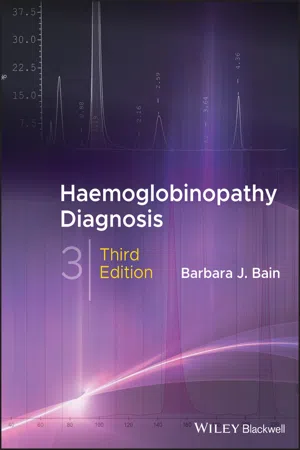
- English
- ePUB (mobile friendly)
- Available on iOS & Android
Haemoglobinopathy Diagnosis
About this book
An updated, essential guide for the laboratory diagnosis of haemoglobin disorders
This revised and updated third edition of Haemoglobinopathy Diagnosis offers a comprehensive review of the practical information needed for an understanding of the laboratory diagnosis of haemoglobin disorders. Written in a concise and approachable format, the book includes an overview of clinical and laboratory features of these disorders. The author focuses on the selection, performance, and interpretation of the tests that are offered by the majority of diagnostic laboratories. The book also explains when more specialist tests are required and explores what specialist referral centres will accomplish. The information on diagnosis is set in a clinical context.
The third edition is written by a leading haematologist with a reputation for educational excellence. Designed as a practical resource, the book is filled with illustrative examples and helpful questions that can aide in the retention of the material presented. Additionally, the author includes information on the most recent advances in the field. This important text:
• Contains a practical, highly illustrated, approach to the laboratory diagnosis of haemoglobin disorders
• Includes "test-yourself" questions and provides an indispensable tool for learning and teaching
• Presents new material on antenatal screening/prenatal diagnostic services
• Offers myriad self-assessment case studies that are ideal for the trainee
Written for trainees and residents in haematology, practicing haematologists, and laboratory scientists, Haemoglobinopathy Diagnosis is an essential reference and learning tool that provides a clear basis for understanding the diagnosis of haemoglobin disorders.
Frequently asked questions
- Essential is ideal for learners and professionals who enjoy exploring a wide range of subjects. Access the Essential Library with 800,000+ trusted titles and best-sellers across business, personal growth, and the humanities. Includes unlimited reading time and Standard Read Aloud voice.
- Complete: Perfect for advanced learners and researchers needing full, unrestricted access. Unlock 1.4M+ books across hundreds of subjects, including academic and specialized titles. The Complete Plan also includes advanced features like Premium Read Aloud and Research Assistant.
Please note we cannot support devices running on iOS 13 and Android 7 or earlier. Learn more about using the app.
Information
1
Haemoglobin and the genetics of haemoglobin synthesis
Haemoglobins and their structure and function

Table of contents
- Cover
- Table of Contents
- Preface
- Abbreviations and glossary
- 1 Haemoglobin and the genetics of haemoglobin synthesis
- 2 Laboratory techniques for the identification of abnormalities of globin chain synthesis
- 3 α, β, δ and γ thalassaemias and related conditions
- 4 Sickle cell haemoglobin and its interactions with other variant haemoglobins and with thalassaemias
- 5 Other significant haemoglobinopathies
- 6 Acquired abnormalities of globin chain synthesis or haemoglobin structure
- 7 Organisation of a haemoglobinopathy diagnostic service
- 8 Self‐assessment: test cases
- Appendix: electronic resources
- Index
- End User License Agreement